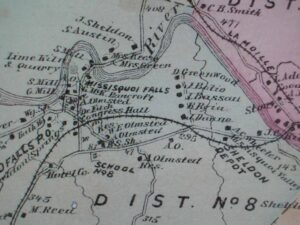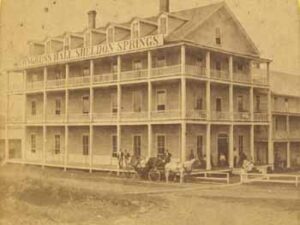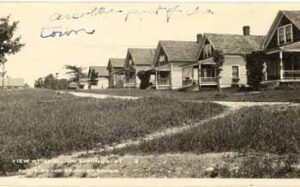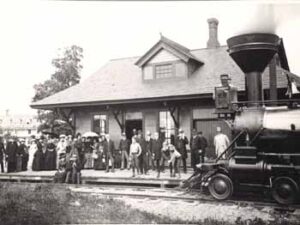
Beers Map Sheldon Springs
First settled by Smith Olmstead and known as “Olmstead Falls,” Sheldon Springs came into existence in the late 1700s. Olmstead was a farmer and the owner of a grist mill at the falls. The Missisquoi River at the north end of the village provided the impetus for the settlement with its source of power. Major Smith built the first saw mill here in 1792 capable of cutting 15,000 feet of lumber a day. George Bancroft owned the Lime Kiln and quarry and manufactured lumber, shingles and lathes. Included within the community were one store, a Missisquoi Railroad station, and Congress Hall. A school house was erected before 1800. The first postmaster in Sheldon Spring was William Adams appointed on June 26, 1871.

CONGRESS HALL
As early as 1609 the mineral water that would transform Olmstead Falls into Sheldon Springs was procured by Samuel D Champlain when natives took skins of water to his ship to aid his wounded and ailing sailors. Between 1865 and 1870 Sheldon became the leading water resort of the United States. Six identified mineral springs resulted in the construction of 11 hotels in Sheldon. Congress Hall, built in 1868 occupied a prominent place at the intersection of Main Street and Shawville Road in Sheldon Springs. The 123 feet by 96 feet four story structure opened to tourists in 1869. Water was drawn from “Kimball Springs”. Included were two bath houses and a large bottling plant. Following the “Boom Years” the hotel was rarely used but the Catholic Church used the dining room for weekly worship. On December 19, 1908 the building burned to the ground at the hands of a disgruntled employee. The land was subsequently deeded to the church. St Anthony’s Church now stands on that corner.

MILL HOUSES
In 1894 J. T. Shipley arrived in Sheldon and built the beginnings of what would become the Missisquoi Pulp and Paper Mill in 1912. Paper manufacturing began in 1914 with up to 250 men employed by the mill. As a result Sheldon Springs became known as a “Company Town” with the company owning the store and some of the community buildings and providing water and electricity to the town. Many of the current structures on what is now Mill Street changed from Main Street by the “Mill” are nearly identical buildings constructed by the mill for workers. The center hub of Sheldon Springs at Mill Street and Shawville Road included houses and garages for the managers of the mill. The mill further developed the town by building employee houses along what is now called School Street, Boarding House Road, and High Street. Many of those structures continue to be occupied today. The mill sold most of its housing units to private citizens in the 1970s.

TRAIN DEPOT AT SPRINGS
The Missisquoi Railroad helped shape the town. The first run from St Albans through Sheldon Springs occurred on July 4 1871. The Missisquoi Valley Railroad sold out to the Central Vermont Railroad and ceased to be a significant or profitable line. Following the abandonment of the line the citizens sought and secured the rail bed and transformed it into the 18 mile long Missisquoi Rail Trail for recreational purposes.
Some historians suggest that Sheldon Springs, aka Oldmstead Falls developed and prospered before Sheldon – the Creek, aka Black Brook Falls. That contention remains agrueable but the prosperity of Sheldon Springs over time, suggested by the number and variety of “Merchants” , gives cause the consider that possibility. Our “Merchants of Sheldon Springs” history strongly suggests a community with a high level of prosperity through the 1800s ad 1900s.
Visit the folllowing pages
Timeline of Merchants 1830 to 2024
The Earliest Merchants of Sheldon Springs
Other Early Merchants
The Company Store
Beyond the Company Store – One Location Many Uses
Other Merchants 1940s to Now
